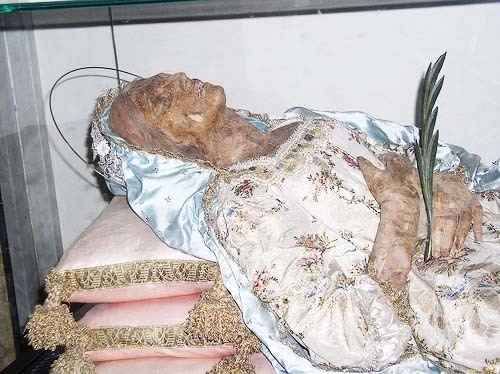Name Saint Zita Canonized 1696 | Feast 27 April | |
 | ||
Attributes depicted with a bag, keys | ||
Venerated in Roman Catholic Church | ||
Princess zita of bourbon parma empress consort of austria
Saint Zita (c. 1212 – 27 April 1272; also known as Sitha or Citha) is an Italian saint, the patron saint of maids and domestic servants. She is often appealed to in order to help find lost keys.
Contents
- Princess zita of bourbon parma empress consort of austria
- Saint Zita
- Life
- Death and canonization
- Veneration
- References

Saint Zita
Life

Saint Zita was born in Tuscany in the village of Monsagrati, not far from Lucca where, at the age of 12, she became a servant in the Fatinelli household. For a long time, she was unjustly despised, overburdened, reviled, and often beaten by her employers and fellow servants for her hard work and obvious goodness. The incessant ill-usage, however, was powerless to deprive her of her inward peace, her love of those who wronged her, and her respect for her employers. By this meek and humble self-restraint, Zita at last succeeded in overcoming the malice of her fellow-servants and her employers, so much so that she was placed in charge of all the affairs of the house. Her faith had enabled her to persevere against their abuse, and her constant piety gradually moved the family to a religious awakening.

Zita often said to others that devotion is false if slothful. She considered her work as an employment assigned to her by God, and as part of her penance, and obeyed her master and mistress in all things as being placed over her by God. She always rose several hours before the rest of the family and employed in prayer a considerable part of the time which others gave to sleep. She took care to hear mass every morning with great devotion before she was called upon by the duties of her station, in which she employed the whole day, with such diligence and fidelity that she seemed to be carried to them on wings, and studied when possible to anticipate them.

One anecdote relates a story of Zita giving her own food or that of her master to the poor. On one morning, Zita left her chore of baking bread to tend to someone in need. Some of the other servants ensured the Fatinelli family was aware of what happened; when they went to investigate, they claimed to have found angels in the Fatinelli kitchen, baking the bread for her.
Death and canonization
St. Benita Zita died peacefully in the Fatinelli house on April 27, 1272. It is said that a star appeared above the attic where she slept at the moment of her death. She was 60 years old, and had served and edified the family for 48 years. By her death, she was practically venerated by the family. After one hundred and fifty miracles wrought in the behalf of such as had recourse to her intercession were juridically proven, she was canonized in 1696.

Her body was exhumed in 1580, discovered to be incorrupt, but has since become mummified. St. Zita's body is currently on display for public veneration in the Basilica di San Frediano in Lucca.
Her feast day in the Roman Catholic Church is April 27. To this day, families bake a loaf of bread in celebration of St. Zita's feast day.
Veneration
Soon after Zita's death a popular cult grew up around her, centring on the church of St Frigidian in Lucca. This was also joined by prominent members of the city. Pope Leo X sanctioned a liturgical cult within the church in the early 16th century, and was confirmed upon her canonization. In 1748, Pope Benedict XIV added her name to the Roman Martyrology.
During the late medieval era, her popular cult had grown throughout Europe. In England she was known under the name Sitha, and was popularly invoked by maidservants and housewives, particularly in event of having lost one's keys, or when crossing rivers or bridges. Images of St. Zita may be seen in churches across the south of England. The church of St Benet Sherehog in London had a chapel dedicated to her, and was locally known as St. Sithes. However, despite her popularity at this time, the cult was not an official one.
